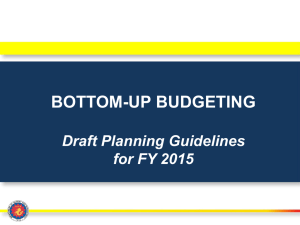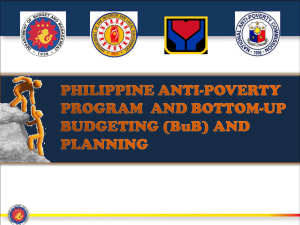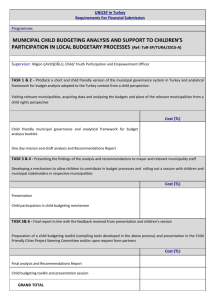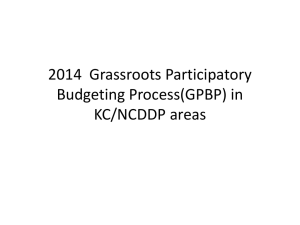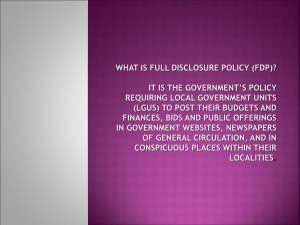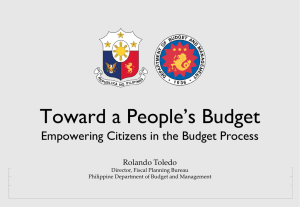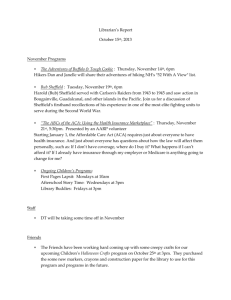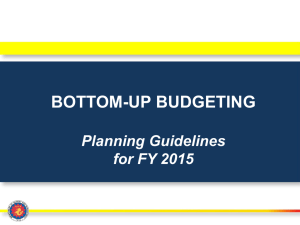Technical Assistance for the Conduct of Grassroots Participatory
advertisement
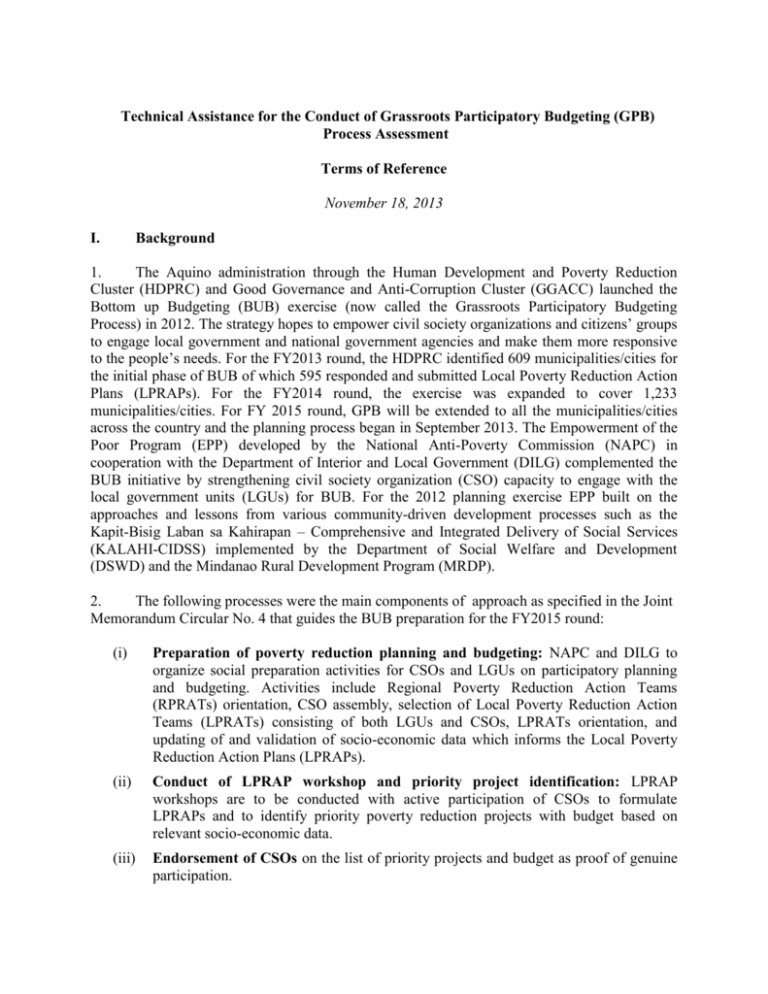
Technical Assistance for the Conduct of Grassroots Participatory Budgeting (GPB) Process Assessment Terms of Reference November 18, 2013 I. Background 1. The Aquino administration through the Human Development and Poverty Reduction Cluster (HDPRC) and Good Governance and Anti-Corruption Cluster (GGACC) launched the Bottom up Budgeting (BUB) exercise (now called the Grassroots Participatory Budgeting Process) in 2012. The strategy hopes to empower civil society organizations and citizens’ groups to engage local government and national government agencies and make them more responsive to the people’s needs. For the FY2013 round, the HDPRC identified 609 municipalities/cities for the initial phase of BUB of which 595 responded and submitted Local Poverty Reduction Action Plans (LPRAPs). For the FY2014 round, the exercise was expanded to cover 1,233 municipalities/cities. For FY 2015 round, GPB will be extended to all the municipalities/cities across the country and the planning process began in September 2013. The Empowerment of the Poor Program (EPP) developed by the National Anti-Poverty Commission (NAPC) in cooperation with the Department of Interior and Local Government (DILG) complemented the BUB initiative by strengthening civil society organization (CSO) capacity to engage with the local government units (LGUs) for BUB. For the 2012 planning exercise EPP built on the approaches and lessons from various community-driven development processes such as the Kapit-Bisig Laban sa Kahirapan – Comprehensive and Integrated Delivery of Social Services (KALAHI-CIDSS) implemented by the Department of Social Welfare and Development (DSWD) and the Mindanao Rural Development Program (MRDP). 2. The following processes were the main components of approach as specified in the Joint Memorandum Circular No. 4 that guides the BUB preparation for the FY2015 round: (i) Preparation of poverty reduction planning and budgeting: NAPC and DILG to organize social preparation activities for CSOs and LGUs on participatory planning and budgeting. Activities include Regional Poverty Reduction Action Teams (RPRATs) orientation, CSO assembly, selection of Local Poverty Reduction Action Teams (LPRATs) consisting of both LGUs and CSOs, LPRATs orientation, and updating of and validation of socio-economic data which informs the Local Poverty Reduction Action Plans (LPRAPs). (ii) Conduct of LPRAP workshop and priority project identification: LPRAP workshops are to be conducted with active participation of CSOs to formulate LPRAPs and to identify priority poverty reduction projects with budget based on relevant socio-economic data. (iii) Endorsement of CSOs on the list of priority projects and budget as proof of genuine participation. (iv) Approval by the Sanggunian before the list is given to national government. (v) Submission of list of priority projects: LPRATs to submit the list, endorsed by the CSOs and approved by the Sanggunian, to the RPRATs through DILG Regional Offices (ROs). (vi) Consolidation of the list of priority projects by Region: DILG ROs will consolidate the lists and send the consolidated lists to RPRATs and NAPC. (vii) Validation and review of priority projects by RPRAT: RPRATs will review and validate the proposed projects. Once approved, RPRATs will submit the list of validated projects to NAPC and the Regional Development Council (RDC). NAPC will then consolidate all the submissions of RPRATs and present it to the BUB oversight agencies for approval. (viii) Integration of LGU projects in the budgets of participating agencies and submission to DBM. (ix) Provision of counterpart funds: LGUs will provide counterpart funds as stipulated in the JMC. (x) Project implementation: LGUs that meet the requirements stipulated in the JMC, such as being the recipient of DILG’s seal of good housekeeping and implementation of Public Financial Management Improvement Plan as determined by the Department of Budget and Management (DBM), will implement the priority projects. Additionally, Guidelines for FY2015 budget preparation aim to integrate the barangay level bottom-up budgeting under KALAHI-CIDSS (KC) program and the GPB process. Municipalities that have graduated from or are currently implementing KC will follow the Enhanced Grassroots Budgeting Process. Under this process, following additional steps have been added: (i) Integration of Participatory Barangay Development Planning: Prior to the conduct of CSO assemblies at the municipal level, DSWD, with support from DILG, will facilitate the participatory barangay development planning in all barangays in KC municipalities. (ii) Integration of the LPRAT into the Enhanced Local Development Council (LDC): The Enhanced LDC, which comprises vice-chairpersons of all Barangay Development Councils, congress person or representative, Punong Barangays, community volunteer representatives from each barangay, chairperson of the appropriations committee, and CSOs, will form an LPRAT which will serve as its technical working group. II. Objective of the Study 3. Since the inception of BUB, the Government has commissioned two rounds of process evaluations – one for FY2013 round and the other for FY2014 round. Key findings were that the BUB process was implemented very differently in the sample sites, and that the variations in the implementation were primarily rooted in the locality’s appreciation of participatory data-based planning processes and the involvement of CSOs in local governance. In the two rounds of implementation for FY2013 and FY2014, BUB has succeeded in making LGUs aware of the need to involve CSOs in development planning and utilizing empirical data for planning purposes. However, data collection and utilization have not improved significantly, and LGUs haven’t appreciated the full potential of participatory planning process primarily due to lack of sufficient facilitation and capacity building.1 4. The Government will undertake another process evaluation for the FY2015 round to examine how the LPRAP planning process and prioritization of the projects are being implemented on the ground and what could be areas for further improvement for the subsequent rounds. Additionally, data on the FY2013 round’s sub-project implementation will be captured to the extent possible to identify any bottlenecks in the implementation process. 5. It is proposed that rapid process evaluation continues to be undertaken annually tracking the same sites in the subsequent rounds to see how the quality and efficiency of the GPB process improves (or not). The proposed evaluation will include the 4 municipalities in Agusan del Norte and Camarines Sur which were surveyed for FY2014 process evaluation to explore any changes in the process. Findings of this process evaluation will result in a set of practical recommendations on possible adjustments in the GPB JMC guidelines as well as to identify areas of possible technical assistance for LPRAP planning and sub-project implementation for the future rounds. III. Scope of the Work The consultant is expected to perform the following tasks: (i) Attend training workshops and participate in drafting the field guide; (ii) Attend LPRAP workshops in selected municipalities and observe the dynamics among the participants; (iii) Act as facilitator in FGDs and conduct KIIs in selected municipalities; and (iv) Document the findings in the field works and come up with an assessment of the BUB process in the field where he or she is assigned; IV. Time Frame 5 man-months V. Deliverables The consultant shall submit a narrative progress report every end of the month throughout the duration of the project. In addition to this, he/she is expected to come up with a documentation of the findings during the field visits and submit a report on the detailed assessment of the BUB process in the selected municipalities. VI. Allotted Budget: 182,000.00 Institute of Philippine Culture. 2013. “Bottom-Up Budgeting Process Evaluation”. Institute of Philippine Culture. Manila. 1

